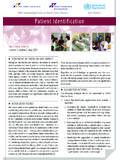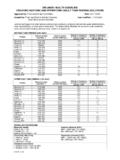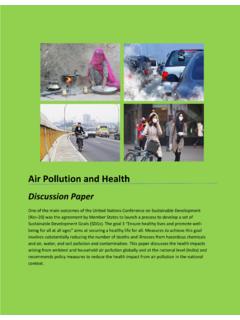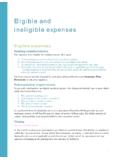Transcription of Patient Safety Solutions - World Health Organization
1 WHO Collaborating Centre for Patient Safety SolutionsAide MemoireS tat e m e n t o f P r o b l e m a n d I mPa c t:During an episode of disease or period of care, a Patient can potentially be treated by a number of Health -care practition-ers and specialists in multiple settings, including primary care, specialized outpatient care, emergency care, surgical care, intensive care, and rehabilitation. Additionally, patients will often move between areas of diagnosis, treatment, and care on a regular basis and may encounter three shifts of staff each day introducing a Safety risk to the Patient at each interval. The hand-over (or hand-off) communication between units and between and amongst care teams might not include all the essential information, or information may be misunder-stood. These gaps in communication can cause serious break-downs in the continuity of care, inappropriate treatment, and potential harm to the in communication was the leading root cause of sentinel events reported to the Joint Commission in the United States of America between 1995 and 2006 (1) and one USA malpractice insurance agency s single most common root cause factor leading to claims resulting from Patient transfer (2).
2 Of the 25 000 to 30 000 preventable adverse events that led to permanent disability in Australia, 11% were due to communication issues, in contrast to 6% due to inadequate skill levels of practitioners (3). Hand-over communication relates to the process of passing pa-tient-specific information from one caregiver to another, from one team of caregivers to the next, or from caregivers to the Patient and family for the purpose of ensuring Patient care con-tinuity and Safety (4). Hand-over communication also relates to the transfer of information from one type of Health -care or-ganization to another, or from the Health -care Organization to the Patient s home. Information shared usually consists of the Patient s current condition, recent changes in condition, ongo- c o m m u n i c a t i o n d u r i n g P a t i e n t H a n d -o v e r sing treatment and possible changes or complications that might occur. Patient care hand-overs occur in many settings across the continuum of care, including admission from primary care, phy-sician sign-out to a covering physician, nursing change-of-shift reporting, nursing report on Patient transfer between units or facilities, anaesthesiology reports to post-anaesthesia recovery room staff, emergency department communication with staff at a receiving facility during a Patient s transfer, and discharge of the Patient back home or to another S So cI at e d IS Su eS :Problems with Patient hand-overs are an international con-cern: Australia (5) and the United Kingdom of Great Britain and Northern Ireland (6) have recently reviewed this issue, and developed risk reduction recommendations.
3 While there are at present no best practices for improving hand-over communica-tion, various strategies have been implemented and are being studied. One study of physician hand-overs concluded that pre-cise, unambiguous, face-to-face communication was the best way to ensure effective hand-overs (7). However, experts in the field of Patient Safety agree that Solutions involving the redesign of systems of care delivery will be the most effective in improv-ing hand-over communication (8). Improved system design will enhance the ability of providers to communicate effectively by taking advantage of knowledge about human factors (how hu-man beings make errors), building redundancies into the proc-esses of care, creating forcing functions, and reducing the steps in the processes and thus reducing the opportunities for part, hand-over problems are rooted in the way that Health -care providers are educated or not educated (in team training and communication skills), lack of good role models, and a Health -care system that promotes and Patient Safety Solutions | volume 1, solution 3 | May 2007rewards autonomy and individual performance.
4 The culture of medicine, which historically has not placed significant emphasis on involving patients and families in the delivery of care, is another root cause. In addition, while speciali-zation of Health -care practitioners can improve medical treatment, specialization of care also means more people and units are involved in the Patient s care, which can com-plicate communication. Another problem contributing to poor communication is that staff composition may not re-flect the demographics of the community being served (9). Also, language problems resulting from a heavy reliance on Health -care professionals from other countries can also lead to communication difficulties. Lessons on how to improve hand-overs are being learned from other high-risk industries such the aviation and nu-clear power industries. One such lesson is the need for a common language for communicating critical information. Incorporating situational briefing techniques such as the SBAR (Situation, Background, Assessment, and Recommendation) process can provide a standard communication framework for Patient care hand-overs (10-11).
5 Simply providing op-portunities for providers of care to ask and resolve questions can improve the effectiveness of hand-over communications (12). Streamlining and standardizing change-of-shift report-ing can enhance critical thinking, as well as minimize time spent away from the Patient (13). Read-back is another ef-fective technique used in hand-overs, where the receiver of information writes down the information and then reads it back to the provider of the information to obtain confir-mation that it was understood correctly. Technologies such as electronic Patient sign-outs have been shown to reduce preventable adverse event rates (14). Collaborative (multi-disciplinary) rounds are being used effectively to improve communication and hand-over of important information re-lating to the Patient s care (15).Involving patients and families in the process of care is in-creasingly being recognized as an important aspect of care delivery. The Patient and family are the only constant and are thus in a position to play a critical role in ensuring con-tinuity of care (16).
6 Hospital discharge is a critical stage where communicating information to patients and families becomes vital (17-19). Engaging patients is sometimes made more difficult due to low Health literacy. The term Health literacy has been defined as the capacity of individuals to obtain, process and understand the basic Health information and services needed to make appropriate Health decisions (20). In the United States, it is estimated that at least 50% of adults have low Health literacy (21). Teach-back is a tech-nique used by caregivers to ensure that the Patient has un-derstood the information provided (22). Teach-back involves asking the Patient to describe what he or she has just heard to assess their u g g eS t e d a c tI o nS :The following strategies should be considered by WHO Member that Health -care organizations implement a standardized approach to hand-over communication between staff, change of shift and between different Patient care units in the course of a Patient transfer.
7 Suggested elements of this approach include:Use of the SBAR (Situation, Background, Assessment, and Recommendation) of sufficient time for communicating important information and for staff to ask and re-spond to questions without interruptions wherever possible (repeat-back and read-back steps should be included in the hand-over process).Provision of information regarding the Patient s sta-tus, medications, treatment plans, advance direc-tives, and any significant status of the exchange of information to that which is necessary to providing safe care to the Patient . 2. Ensure that Health -care organizations implement sys-tems which ensure at the time of hospital discharge that the Patient and the next Health -care provider are given key information regarding discharge diagnoses, treatment plans, medications, and test results. 3. Incorporate training on effective hand-over com-munication into the educational curricula and con-tinuing professional development for Health -care Encourage communication between organizations that are providing care to the same Patient in parallel (for example, traditional and non-traditional providers).
8 Lo o kI n g f o r wa r d :Where available, explore technologies and methods that can improve hand-over effectiveness, such as electronic medical records, electronic prescribing systems and au-tomated medication reconciliation, to streamline infor-mation access and procedures to ensure that processes which use electronic technology are interactive and effective and allow time for questions or updates regarding the care of the Patient . a P Pl I c a bI l I t y:All Health -care organizations and Health -care settings. 1. P ot e n tI a l b a r rI e rS : Resistance of caregivers to change pressures from Patient care needs and other and time cost of implementing new hand-over and language differences among Patient popu-lation and workforce. Low Health literacy. Lack of financial resources and staffing shortages. Lack of knowledge about how to improve of leadership to require implementation of new systems and of information technology infrastructure and generally accepted research, data, and economic rationale regarding cost-benefit analysis or return on investment (ROI) for implementing these I Sk S f o r u n I n t e n d e d c o nS e q u e n c eS :Delays in Patient care due to increased hand-over time.
9 O P Po r t u nI t I e S f o r PatI e n t a n d fa mI ly I n v o lv e m e n t:Provide information to patients about their medical con-ditions and treatment care plan in a way that is under-standable to patients aware of their prescribed medications, doses, and required time between medications. Inform patients who the responsible provider of care is during each shift and who to contact if they have a con-cern about the Safety or quality of patients with the opportunity to read their own medical record as a Patient Safety opportunities for patients and family members to address any medical care questions or concerns with their Health -care patients and family members of the next steps in their care, so they can if necessary communicate this to the care provider on the next shift, or so they are pre-pared to be transferred from one setting to the next, or to their patients and family members in decisions about their care at the level of involvement that they t r e n g tH o f e v I d e n c e :Expert opinion/consensus and several descriptive studies.
10 EXAMPLE OFCommunication During Patient Hand-OversPolicyProviderHand-overcommuni cationDischargeHand-overcommunicationShi ft-to shift, Unit-to-unitPut in place a standardized approach to hand-over communication between staff change of shift and between different Patient care units in the course of a Patient transfer. Ensure that a responsible provider has updated information regarding the Patient s status, medications, treatment plans, advance directives, and any significant status patients and family members in decisions about their care at the level of involvement they choose. Provide patients with information about their medical condition and treatment care plan in a way that is understandable to the Patient . Use a standardized approach to minimize sufficient time for staff to ask and respond to repeat-back and read-back steps as part of the hand-over the exchange to information that is necessary to providing safe care to the Patient .

















